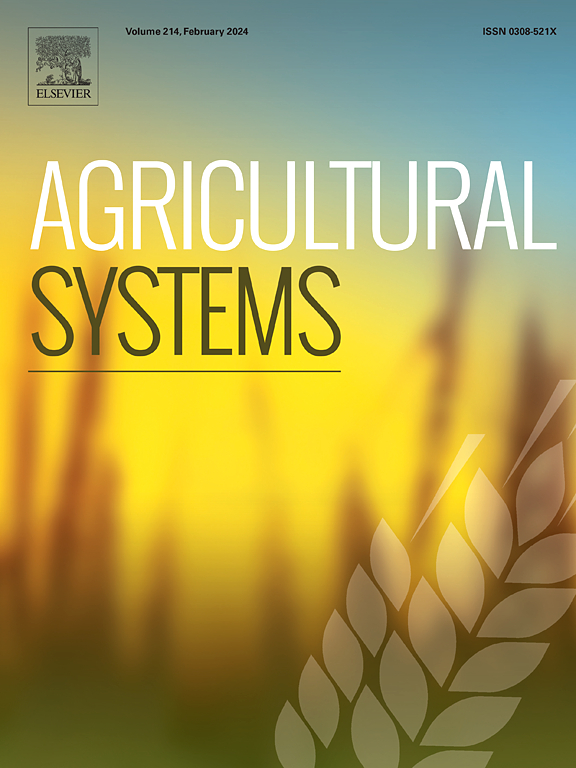无性繁殖作物种子部门发展的政策和法规:来自肯尼亚、尼日利亚和越南的见解
IF 6.1
1区 农林科学
Q1 AGRICULTURE, MULTIDISCIPLINARY
引用次数: 0
摘要
在许多低收入和中等收入国家,种植无性繁殖作物(VPCs)的小农获得优质种植材料的机会有限。这种约束会限制VPC栽培的产量和回报。然而,迄今为止,旨在加强获得优质VPC种植材料和扩大提供这些材料的创新项目的政策和法规相对不成功。部分问题在于无性繁殖的独特的生物学和经济特征,以及它与谷类作物的区别,这些特征主导着种子部门改革以及由此产生的政策和监管制度的叙述。目的:本研究分析了现有的和可替代的监管模型的理论和证据,这些模型可能会激励VPC种子系统和市场中具有成本效益的繁殖和分配。方法本研究借鉴了尼日利亚和越南的木薯以及肯尼亚和越南的马铃薯这四种作物-国家组合中与质量保证法规相关的政策和实践案例研究。案例研究依赖于定性分析,这种定性分析结合了关键信息者访谈、焦点小组讨论、监管文件分析和公开二手数据分析。该研究描述了在我们的四种作物-国家组合中调节VPC种子系统的五种策略,每种策略都有其可推广的成本和收益。这些战略的应用(或边缘化)往往是由具有相互竞争的利益和框架叙述的行动者组成的不稳定联盟所决定的,并受到组织创新、技术机会、贸易关系和针对特定作物和国家的危机的推动。这些发现表明,围绕严格、集中的质量控制系统设计的法规往往会限制市场规模,而更本地化的生产系统则受到能力和覆盖范围的限制。他们还建议,需要有一种替代方案,能够平衡宽松的监管制度与分散的生产系统、基层能力发展、市场监督和整合多种质量保证方法的系统。这些调查结果提出了一套详细的政策建议,为各国正在努力修订VPC种子部门的政策和法规提供了信息,这些改革不仅在这里强调的种植国案例研究中进行,而且在非洲和亚洲的其他国家也在进行。本文章由计算机程序翻译,如有差异,请以英文原文为准。

Policy and regulation in seed sector development for vegetatively propagated crops: Insights from Kenya, Nigeria, and Vietnam
Context
In many low- and middle-income countries, smallholder farmers cultivating vegetatively propagated crops (VPCs) have limited access to quality planting material. This constraint can limit both the yield and returns to VPC cultivation. Yet policy and regulations designed to strengthen access to quality VPC planting materials and scale innovative programs that deliver these materials have been relatively unsuccessful to date. Part of the problem lies the unique biological and economic characteristics of vegetative propagation and its distinctness from cereal crops that dominate narratives on seed sector reforms and the resulting policy and regulatory regimes.
Objective
The study analyzes both theory and evidence on existing and alternative models of regulation that may incentivize cost-effective multiplication and distribution in VPC seed systems and markets.
Methods
The study draws on case studies of policy and practice related to quality assurance regulations in four crop-country combinations: cassava in Nigeria and Vietnam, and potato in Kenya and Vietnam. The case studies rely on qualitative analysis that was conducted using a combination of key informant interviews, focus group discussions, analysis of regulatory documents, and analysis of publicly available secondary data.
Results and conclusions
The study describes five strategies for regulating VPC seed systems in our four crop-country combinations, each with its own generalizable costs and benefits. The application (or marginalization) of these strategies is often shaped by fluid coalitions of actors with competing interests and framing narratives, and driven by organizational innovations, technological opportunities, trade relationships, and crises that are crop- and country-specific.
Significance
These findings suggest that regulations designed around strict, centralized quality control systems tend to limit market size, while more localized production systems are limited by both capacity and reach. They also suggest the need for alternatives that balance a permissive regulatory regime with decentralized production systems, grassroots capacity development, market surveillance, and systems that integrate multiple approaches to quality assurance. A detailed set of policy recommendations follows from these findings that inform ongoing country efforts to revise VPC seed sector policies and regulations—reforms that are being pursued not only in the crop-country case studies highlighted here, but also in other countries in both Africa and Asia.
求助全文
通过发布文献求助,成功后即可免费获取论文全文。
去求助
来源期刊

Agricultural Systems
农林科学-农业综合
CiteScore
13.30
自引率
7.60%
发文量
174
审稿时长
30 days
期刊介绍:
Agricultural Systems is an international journal that deals with interactions - among the components of agricultural systems, among hierarchical levels of agricultural systems, between agricultural and other land use systems, and between agricultural systems and their natural, social and economic environments.
The scope includes the development and application of systems analysis methodologies in the following areas:
Systems approaches in the sustainable intensification of agriculture; pathways for sustainable intensification; crop-livestock integration; farm-level resource allocation; quantification of benefits and trade-offs at farm to landscape levels; integrative, participatory and dynamic modelling approaches for qualitative and quantitative assessments of agricultural systems and decision making;
The interactions between agricultural and non-agricultural landscapes; the multiple services of agricultural systems; food security and the environment;
Global change and adaptation science; transformational adaptations as driven by changes in climate, policy, values and attitudes influencing the design of farming systems;
Development and application of farming systems design tools and methods for impact, scenario and case study analysis; managing the complexities of dynamic agricultural systems; innovation systems and multi stakeholder arrangements that support or promote change and (or) inform policy decisions.
 求助内容:
求助内容: 应助结果提醒方式:
应助结果提醒方式:


